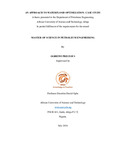| dc.description.abstract | Waterflooding is the most dominant secondary oil recovery method and its popularity is mainly due to the general availability of water, the relative ease of injecting water, the ability of water to spread easily through an oil-bearing formation and the efficiency of water in displacing oil. However, waterflooding is not without its challenges. Factors such as reservoir heterogeneity, lateral and vertical variations in permeability and presence of discontinuities greatly affect this process.
This study is aimed at optimizing waterflooding in a case study using geostatistical reservoir characterization and simulation techniques. The impact of variations in kV/kH ratios across the reservoir on the performance of waterflooding is analyzed. The analysis of the effects of zones of production and injection as well as the waterflood pattern selected on cumulative recovery from a waterflooded reservoir was carried out. The waterflood patterns considered were the regular five-spot, the direct line drive and the staggered line drive patterns. The results were analyzed by evaluating trends of average reservoir pressure, oil producing rate, cumulative oil production and field water-cut over time for several scenarios of the waterflood. These trends were also compared to a base case; a case of reservoir depletion without waterflooding.
The results showed that variations in kV/kH ratio play a significant role in the performance of waterflooding. Finally, the optimal waterflood pattern of all the patterns studied was the direct-line waterflood pattern which gave the highest oil recovery.
This study has demonstrated that geostatistical reservoir characterization and simulation techniques are good tools for reservoir management. It has also shown that variation in kV/kH ratios, zones of injection and production and the waterflood pattern used to produce the oil affect the performance of a waterflooding process greatly. | en_US |

